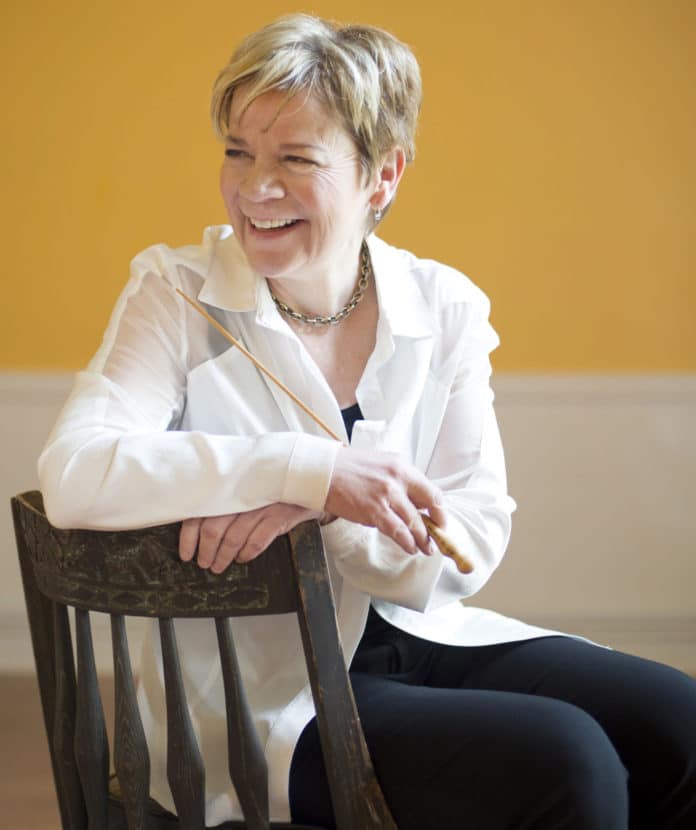“We need to ask ourselves if artistic excellence is the ultimate goal. Other things may be more important.”
She said it. Sitting on the stage of the Meyerhoff concert hall in Baltimore last week, the conductor Marin Alsop, music director of the Baltimore Symphony Orchestra, stated a question that’s been lurking around the edges of the orchestra world. That is: Is the main purpose of orchestras to play great music, as well as humanly possible? And if not, what is it?
Never before have our large institutions been subject to such a string of existential questions. How do we justify the continued existence of our (orchestras, newspapers, insert institution of your choice here)? How do we make these institutions relevant to an audience that is pulling away, finding other ways to get music and information? The scrutiny isn’t necessarily a bad thing, but it’s shining a light on some unexpected baggage.
Alsop’s statement came at the start of the annual conference of the League of American Orchestras, which was held in Baltimore last week, and which this year aspired to tackle the timely topic of diversity. Today, 85 percent of American orchestra players are Caucasian; 8 percent are Asian, a growing number, and less than 2 percent are African-American. And that’s not even counting the audiences.
How do you broaden this music’s appeal? Should you even try? I’ve heard from more than one reader over the years averring that an orchestra’s role is simply to play the music of Beethoven, Brahms and their ilk: Forget contemporary stuff, much less diversity.
“You can’t change the canon,” opined Alex Laing, the principal clarinet of the Phoenix Symphony, in a panel discussion at the start of the proceedings. But Earl Lewis, the head of the Mellon Foundation – the main remaining funder of the orchestral world – challenged him with the precedent, in literary circles, of resistance to black women writers for years before Alice Walker and Toni Morrison finally got their due. It just takes time. “You have to look ahead 15 years, not five years,” he said, “or you’ll get frustrated.”
Over the course of the conference’s first day, Alsop and her orchestra demonstrated to their colleagues what other concerns, apart from artistic excellence, might occupy an orchestra – and what diversity might look like. In the afternoon, the league members were treated to a vivid performance by members of OrchKids, the program Alsop helped launch eight years ago for inner-city children, and which now works with some 2,000 kids.
Orchestras these days are fond of presenting educational initiatives as panaceas for the problem of audience decline; I hold that the decline in audiences and in music education are both symptoms of the same societal shift, rather than cause and effect. But it’s hard to argue with the kind of concrete, day-to-day work that OrchKids has done with these students, who, in a rainbow of bright T-shirts, sang along to Sibelius’s “Finlandia” and danced while playing New Orleans-style brass.
In the evening, the BSO showed another face of community involvement with a performance of Copland’s “Appalachian Spring,” accompanied by a reconstruction of the Martha Graham choreography, danced by high school students from the Baltimore School for the Arts. No, the dancers weren’t professional. Yes, it was still a worthwhile performance.
The concert also included a world premiere by James Lee III, “Thurgood’s Rhapsody,” a big, intense burst of music (one of 10 short works commissioned for the orchestra’s centennial by the company Classical Movements); Thomas Adès’s “Polaris,” during which the orchestra beta-tested a smartphone app with accompanying program notes; and an exuberant performance of Ravel’s second suite from “Daphnis and Chloe,” with the offstage chorus sounding woody and feral and the orchestra and Alsop sounding notably liberated. In short, there was something for everyone, including some interesting hypotheses about an orchestra’s role.
Meanwhile, down the road in College Park, the National Orchestral Institute – the annual training ground at the University of Maryland for gifted young musicians – is taking a different kind of look at orchestras’ futures. The NOI is right in line with ongoing concerns about diversity; this year, it partnered with the Sphinx Foundation, devoted to promoting diversity in the arts. It’s also eager to broaden the canon. Saturday night’s concert, led by U-Md.’s conducting guru James Ross, focused entirely on the music of American composers – and was recorded for future CD release by the label Naxos, now in the second year of partnership with the institute.
Administrators are concerned about the future of orchestras, but these young players certainly didn’t sound so. The clock turned back to the 1930s with the eager, impassioned first symphony by Samuel Barber, in a performance as vivid as any you’re likely to encounter. Neither of the other two pieces on the program was any more familiar. Samuel Adams, son of the composer John, who is forging a starry career for himself already, was represented with the 2012 piece “Drift and Providence,” an evocative onomotopaeic five-movement tone poem about the sea, with an unobtrusive computer soundscape holding out tones gently, like the last rays of sunlight on a distant ocean horizon.
Least striking was Randall Thompson’s third symphony, but that wasn’t the players’ fault: It was just too controlled, too mannered, dating itself with the lush, almost big-band sound of its second movement, and betraying its restraint in its inability to let go with the hoe-downing movement of its fourth.
An underlying problem with orchestras that no one explicitly addressed last week: They’re so mired in their sense of exalted purpose that they’re often not much fun. Getting away from “excellence” may mean, in part, just getting away from the straitjacket of tradition. Both of these concerts were useful reminders that the point of the exercise is not worshiping at familiar altars, but making music. If only it’s not too late to get audiences to listen.






